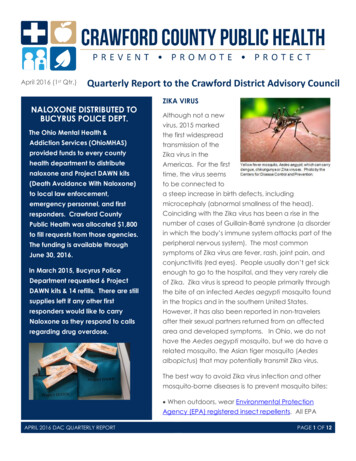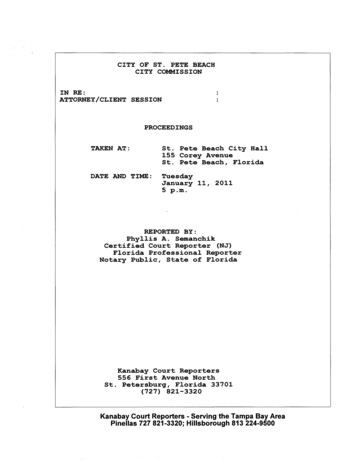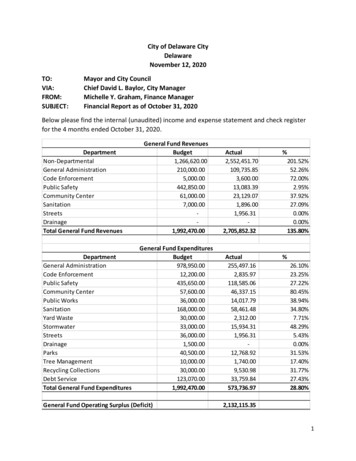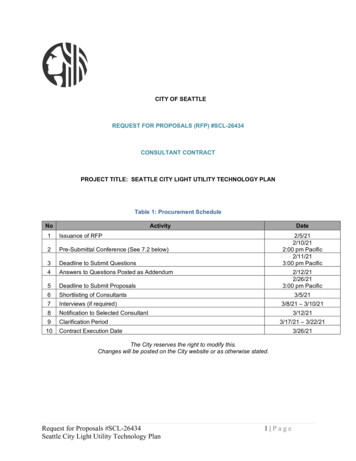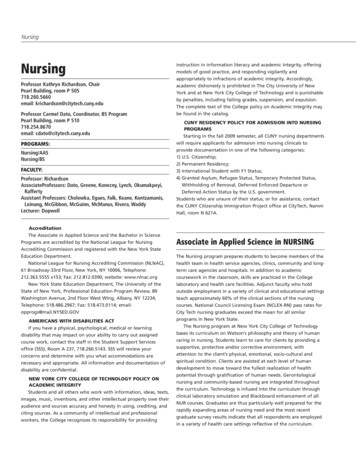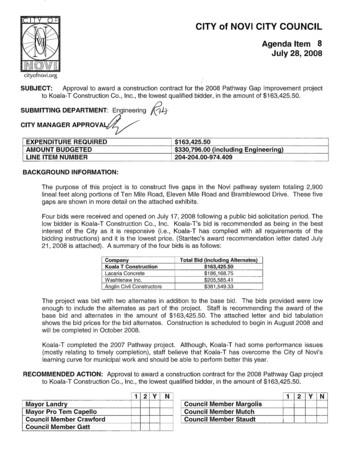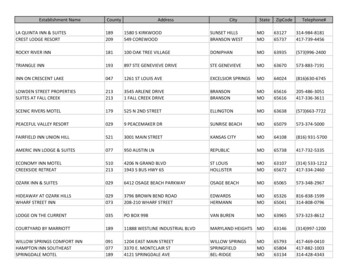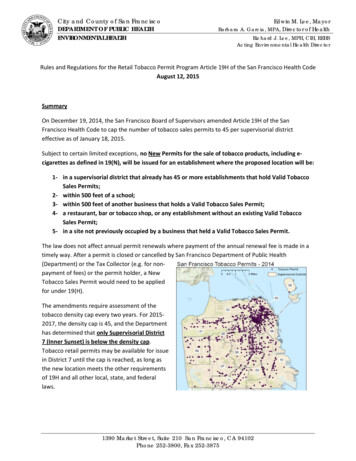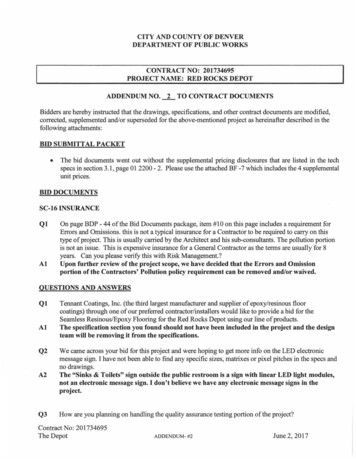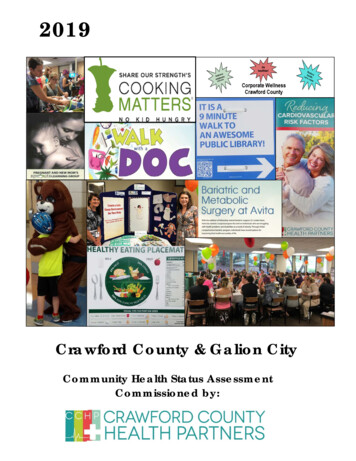
Transcription
2019Crawford County & Galion CityCommunity Health Status AssessmentCommissioned by:
ForewordDear Community Member,Members of the Crawford County Health Partners are proud to present the 2019 Crawford County HealthAssessment. This report is the result of dedication to a partnership that is focused on improving the health of ourcommunity.This Community Health Assessment is a data-driven look at the health of adults and youth who live in CrawfordCounty and the City of Galion. It compares Crawford County and Galion City newly collected data to informationfrom previous assessments, as well as to data from across the state of Ohio and the United States.This document will highlight the strengths and needs of Crawford County, so that organizations involved in theassessment process can make sound decisions using the best available data. It should help identify unmet needs,increase access to services, and provide insight into the best ways to improve the quality of life for people inCrawford County. A community’s quality of life is measured in many ways. Every measure includes its health status,and having a healthier population leads to a higher quality of life for all. Using this assessment as just one tool, anyand every organization can play a role, large or small, in making Crawford County an even better place to live andwork.While addressing every challenge or opportunity for improvement would surely be overwhelming, the 2019Community Health Assessment should help guide health priorities in Crawford County for the next several years orlonger. It is our hope that this report will be informative not only for the general public, but also to organizationsthat will use the data to write grant requests, form strategic plans, and motivate communities to becomechampions for positive change.Partnership has been the hallmark of the process that led to the creation of this report. The Crawford County HealthPartners sought to include as many stakeholders as possible so that the Community Health Assessment representstheir interests and reflects their needs.This report would not exist without the financial support of community organizations that care about your health. Inaddition, the project was supported and driven by community organizations that comprise the Crawford CountyHealth Partners. Their hard work and dedication in planning the assessment and community involvement made thisall possible. Please see the acknowledgements page for a list of both funding agencies and Crawford CountyHealth Partners that were involved in the Community Health Assessment project. Special thanks are given to TessaElliott of the Hospital Council of Northwest Ohio for guiding this process.While data is useful, it is how people utilize this information that ultimately benefits the community. Please join theCrawford County Health Partners as we work together to improve the health and well-being of all Crawford Countyresidents. We encourage you to be open to new ideas and collaborations. We also encourage you to remainoptimistic and positive about the excellent work this community can do together.Sincerely,Cinda M. Kropka , MHACompliance/ Ethics & Privacy DirectorAvita Health SystemKate Siefert, RS, MPHHealth CommissionerCrawford County Public HealthTrish Factor, MPH, MCHES, CHEPHealth CommissionerGalion City Health DepartmentFOREWORD 1
AcknowledgementsThis report has been funded by:Avita Health SystemCrawford County Public HealthGalion City Health DepartmentCrawford County Board of Developmental DisabilitiesCrawford Partnership for Education & Economic DevelopmentCrawford-Marion ADAMH BoardTogether We Hurt Together We HealUnited Way of Crawford CountyThis report has been commissioned by the Crawford County Health Partners:Avita Health SystemCrawford County Public HealthGalion City Health DepartmentCrawford County Board of Developmental DisabilitiesCrawford Partnership for Education & Economic DevelopmentCrawford-Marion ADAMH BoardTogether We Hurt Together We HealUnited Way of Crawford CountyCommunity CounselingCommunity Foundation for Crawford CountyFamily Life Counseling- GalionMarion Crawford Prevention ProgramsMaryhavenWesley Chapel/Restore MinistriesAll Crawford County School DistrictsContact InformationTrish FactorGalion City Health Department113 Harding Way EastGalion, Ohio 44833trish.factor@galionhealth.org419-468-1075 ext. 1264Cinda KropkaAvita Health System269 Portland Way SGalion OH 44833ckropka@avitahs.org419-468-0571Kate SiefertCrawford County Public Health1520 Isaac Beal RoadBucyrus, Ohio 44820kate.siefert@crawfordhealth.org419-562-5871 ext. 1213ACKNOWLEDGEMENTS 2
Project Management, Secondary Data, Data Collection, and Report DevelopmentBritney L. Ward, MPHDirector of Community Health ImprovementMargaret Wielinski, MPHAssistant Director of Community Health ImprovementTessa Elliott, MPHCommunity Health Improvement CoordinatorEmily A. Golias, MPH, CHESCommunity Health Improvement CoordinatorEmily Stearns, MPH, CHESCommunity Health Improvement CoordinatorLayla Abraham, MPHCommunity Health Improvement CoordinatorErin RauschenbergGraduate AssistantEmily SolesGraduate AssistantCarolynn McCartneyUndergraduate AssistantAlyssa MillerGraduate AssistantData Collection & AnalysisJoseph A. Dake, Ph.D., MPHProfessor and ChairSchool of Population HealthUniversity of ToledoAaron J Diehr, PhD, CHESConsultantTo see Crawford County data compared to other counties, please visit the Hospital Council ofNorthwest Ohio’s Data Link website mlThe 2018/19 Crawford County Health Assessment is available on the following websites:Avita Health System - http://www.avitahealth.orgCrawford County Public Health - http://crawfordhealth.com/Galion City Health Department - http://galionhealth.org/Hospital Council of Northwest Ohio - DGEMENTS 3
Table of ContentsExecutive SummaryInternal Revenue Services (IRS) RequirementsPublic Health Accreditation Board (PHAB)Primary Data Collection MethodsSecondary Data Collection Methods2016 Ohio State Health Assessment (SHA)Data SummaryTrend SummaryPages 6-26Pages 6-7Page 8Pages 8-10Page 10Page 11Pages 12-26Pages 27-30HEALTH CARE ACCESSHealth Care CoverageAccess and UtilizationPreventive MedicineWomen’s HealthMen’s HealthOral HealthPages 31-33Pages 34-37Pages 38-40Pages 41-43Pages 44-45Pages 46-47HEALTH BEHAVIORSHealth Status PerceptionsAdult Weight StatusAdult Tobacco UseAdult Alcohol ConsumptionAdult Drug UseAdult Sexual BehaviorAdult Mental HealthPages 48-49Pages 50-54Pages 55-57Pages 58-60Pages 61-66Pages 67-70Pages 71-75CHRONIC DISEASECardiovascular HealthCancerArthritisAsthma and Other Respiratory DiseaseDiabetesQuality of LifePages 76-80Pages 81-84Page 85Pages 86-88Pages 89-90Pages 91-92SOCIAL CONDITIONSAdult Social Determinants of HealthEnvironmental ConditionsParentingPages 93-101Page 102Page 103GALION CITYHealth Care AccessChronic Disease and Health BehaviorsSocial ConditionsPages 104-105Pages 106-109Pages 110-111TABLE OF CONTENTS 4
YOUTH HEALTHYouth Weight StatusYouth Tobacco UseYouth Alcohol ConsumptionYouth Drug UseYouth Mental HealthYouth Social Determinants of HealthYouth ViolencePages 112-114Pages 115-117Pages 118-122Pages 123-126Pages 127-130Pages 131-135Pages 136-140APPENDICESAPPENDIX I — Health Assessment Information SourcesAPPENDIX II — Acronyms and TermsAPPENDIX III — School ParticipationAPPENDIX IV — Weighting MethodsAPPENDIX V — Sample Demographic ProfileAPPENDIX VI — Demographics and Household InformationAPPENDIX VII — County Health RankingsPages 141-143Page 144Page 145Pages 146-147Pages 148-149Pages 150-156Pages 157-159TABLE OF CONTENTS 5
Executive SummaryThis executive summary provides an overview of health-related data for Crawford County adults (ages 19 and older)who participated in a county-wide health assessment survey from September through October 2018 and youth(ages 12 through 18) who participated in a county-side health assessment survey in February 2019. The findings arebased on self-administered surveys using a structured questionnaire. The questions were modeled after the surveyinstruments used by the Centers for Disease Control and Prevention for their national and state Behavioral RiskFactor Surveillance System (BRFSS) and Youth Risk Behavior Surveillance System (YRBSS). The Hospital Council ofNorthwest Ohio (HCNO) collected the data, guided the health assessment process and integrated sources ofprimary and secondary data into the final report.The state of Ohio mandated by law (ORC 3701.981) that all hospitals must collaborate with their local healthdepartments on community health assessments (CHA) and community health improvement plans (CHIP). Inaddition, local hospitals must align with the Ohio State Health Assessment (SHA). This requires alignment of theCHA process timeline and indicators. This local alignment must take place by October 2020. Avita Health Systemcollaborated with the Crawford County Health Department, the Galion City Health Department and other partnersto create the 2018/19 Crawford County CHA. Avita Health System will also be participating in the upcoming CHIP,which along with the CHA, will align partners to be in compliance by 2020.Internal Revenue Services (IRS) RequirementsThe Affordable Care Act (ACA), enacted in March 2010, added new Section 501 (r) requirements in Part V, Section B,on 501 (c)(3) organizations that operate one or more hospital facilities. Each 501 (c)(3) hospital organization mustconduct a community health needs assessment and adopt an implementation strategy at least once every threeyears. This report meets these IRS requirements.DEFINITION OF COMMUNITY & SERVICE AREA DETERMINATIONThe community has been defined as Crawford County. Most (75%) of Avita Health System’s discharges in 2018 wereresidents of Crawford County. In addition, Avita Health System collaborates with multiple stakeholders, most ofwhich provide services at the county-level. For these two reasons, the county was defined as the community.INCLUSION OF VULNERABLE POPULATIONSCrawford County is a rural county. Approximately 16.2% of Crawford County residents were below the poverty line,according to the 2013-2017 American Community Survey 5-year estimates. For this reason, data is broken down byincome (less than 25,000 and greater than 25,000) throughout the report to show disparities.PROCESS & METHODS FOR ENGAGING COMMUNITYThis community health needs assessment process was commissioned by The Crawford County Health Partners. Thiscoalition has been in existence for 4 years and includes approximately 15 area organizations. Multiple sectors,including the general public, were asked through email list servs, social media, and public notices to participate inthe process which included defining the scope of the project, choosing questions for the surveys, reviewing initialdata, planning a community release, and identifying and prioritizing needs.QUANTITATIVE & QUALITATIVE DATA ANALYSISThe Hospital Council of Northwest Ohio was contracted to collect and analyze the data, as well as overall projectmanagement. Detailed data collection methods are described later in this section.EXECUTIVE SUMMARY 6
EVALUATION OF IMPACTThe evaluation of impact takes into consideration the feedback from the last community health needs assessment.The Crawford County Health Partners have a quarterly score card that tracks impact of priority action steps.CHNA AVAILABILITYThe 2019 Crawford Health Community Health Needs Assessment, as well as the various other assessments used increating this report, can be found at the following websites:Avita Health System: www.avitahealth.orgCrawford County Public Health: http://www.crawford-co.org/Galion City Public Health: www.galionhealth.orgHospital Council of Northwest Ohio: ealth-assessments/Public Health Accreditation Board (PHAB)National public health accreditation status through the Public Health Accreditation Board (PHAB) requirescommunity health assessments (CHAs) to be completed at least every five years. The purpose of the communityhealth assessment is to learn the health of the population and identify areas for health improvement, contributingfactors that impact health outcomes, and community assets and resources that can be mobilized to improvepopulation health.PHAB standards highly recommend that national models of methodology are utilized in compiling CHAs. The 2019CHA was completed using the National Association of County and City Health Officials (NACCHO) Mobilizing Actionthrough Partnerships and Planning (MAPP) process. MAPP is a community-driven planning process for improvingcommunity health. This process was facilitated by HCNO in collaboration with various local agencies representing avariety of sectors.This assessment includes a variety of data and information from various sources, focusing on primary data at thecounty and city level. Supporting data, such as secondary data; demographics; health disparities (including age,gender, and income-based disparities); and social determinants of health can be found throughout the report. For amore detailed approach on primary data collection methods, please see the section below.Primary Data Collection MethodsDESIGNThis community health assessment was cross-sectional in nature and included a written survey of adults andadolescents within Crawford County. From the beginning, community leaders were actively engaged in theplanning process and helped define the content, scope, and sequence of the study. Active engagement ofcommunity members throughout the planning process is regarded as an important step in completing a validneeds assessment.INSTRUMENT DEVELOPMENTTwo survey instruments were designed, and pilot tested for this study: one for adults and one for adolescents ingrades 6 through 12. As a first step in the design process, health education researchers from the University ofToledo and staff members from HCNO met to discuss potential sources of valid and reliable survey items thatwould be appropriate for assessing the health status and health needs of adults and adolescents. The investigatorsdecided to derive most the adult survey items from the BRFSS and many of adolescent survey items from theYRBSS. This decision was based on being able to compare local data with state and national data.The project coordinator from the Hospital Council of Northwest Ohio conducted a series of meetings with theCrawford County Health Partners. During these meetings, HCNO and the planning committee reviewed anddiscussed banks of potential survey questions. Based on input from the Crawford County planning committee, theproject coordinator composed drafts of surveys containing 116 items for the adult survey and 75 items for theadolescent survey. Health education researchers from the University of Toledo reviewed and approved the drafts.EXECUTIVE SUMMARY 7
SAMPLING Adult SurveyThe sampling frame for the adult survey consisted of adults ages 19 and older living in Crawford County. Therewere 33,056 persons ages 19 and older living in Crawford County. The investigators conducted a power analysis todetermine what sample size was needed to ensure a 95% confidence level with a corresponding margin of error of5% (i.e., we can be 95% sure that the “true” population responses are within a 5% margin of error of the surveyfindings). A sample size of at least 380 adults was needed to ensure this level of confidence. The random sample ofmailing addresses was obtained from Melissa Global Intelligence in Rancho Santa Margarita, California.SAMPLING Adolescent SurveyYouth in grades 6 through 12 in Crawford County public school districts were used as the sampling frame for theadolescent survey. Using the U.S. Census Bureau data, it was determined that approximately 4,233 youth ages 12 to18 years old live in Crawford County. A sample size of 352 adolescents was needed to ensure a 95% confidenceinterval with a corresponding 5% margin of error. Students were randomly selected and surveyed in the schools.PROCEDURE Adult SurveyPrior to mailing the survey, the project team mailed an advance letter to 1,200 adults in Crawford County. Anadditional 300 letters were mailed to adults living in Galion City. This advance letter was personalized; printed onCrawford County Health Partners letterhead; and signed by Trish Factor, MPH, MCHES, CHEP, Health Commissioner,Galion City Health Department and Kate Siefert, RS, Administrator, Crawford County Public Health. The letterintroduced the county health assessment project and informed the readers that they may be randomly selected toreceive the survey. The letter also explained that the respondents’ confidentiality would be protected andencouraged the readers to complete and return the survey promptly if they were selected.Three weeks following the advance letter, the project team implemented a three-wave mailing procedure tomaximize the survey return rate. The initial mailing included a personalized hand-signed cover letter (on CrawfordCounty Health Partners letterhead) describing the purpose of the study, a questionnaire, a self-addressed stampedreturn envelope, and a 2 incentive. Approximately three weeks after the first mailing, a second wave mailingincluded another personalized cover letter encouraging them to reply, another copy of the questionnaire, andanother reply envelope. A third wave postcard was sent three weeks after the second wave mailing. Surveysreturned as undeliverable were not replaced with another potential respondent.The response rate for the mailing was 42% (n 564: CI 4.09). This return rate and sample size means that theresponses in the health assessment should be representative of the entire county. There were 114 adults living inGalion City who responded to the survey and the data is not generalizable to the entire population.PROCEDURE Adolescent SurveyThe survey was approved by all participating superintendents. Schools and grades were randomly selected. Eachstudent in the selected grades had to have an equal chance of being in the class that was selected, such as ageneral English or health class. Classrooms were chosen by the school principal. Passive permission slips weremailed home to parents of any student whose class was selected to participate. The response rate was 94% (n 436:CI 4.43).DATA ANALYSISIndividual responses were anonymous. Only group data was available. All data was analyzed by health educationresearchers at the University of Toledo using SPSS 24.0. Crosstabs were used to calculate descriptive statistics forthe data presented in this report. To be representative of Crawford County, the adult data collected was weightedby age, gender, race, and income using 2017 Census data. Multiple weightings were created based on thisinformation to account for different types of analyses. For more information on how the weightings were createdand applied, see Appendix IV.EXECUTIVE SUMMARY 8
LIMITATIONSAs with all county health assessments, it is important to consider the findings with respect to all possiblelimitations. First, the Crawford County adult assessment had a high response rate. However, if any importantdifferences existed between the respondents and the non-respondents regarding the questions asked, this wouldrepresent a threat to the external validity of the results (the generalizability of the results to the population ofCrawford County). If there were little to no differences between respondents and non-respondents, then this wouldnot be a limitation.Also, it is important to note that, although several questions were asked using the same wording as the CDCquestionnaires, the adult data collection method differed. CDC adult data was collected using a set of questionsfrom the total question bank, and adults were asked the questions over the telephone rather than via mail su
Aug 02, 2017 · The state of Ohio mandated by law (ORC 3701.981) that all hospitals must collaborate with their local health departments on community health assessments (CHA) and community health improvement plans (CHIP). In addition, local hospitals must align with the Ohio Stat
